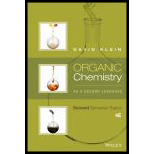
Interpretation:
The expected directing effects that would be observed if the given compound undergoes an electrophilic
Concept Introduction:
Electrophilic substitution reaction is a type of reaction in which a particular group or atom in a compound is replaced by electrophile. An electrophile is a species that is deficient of electrons
Deactivators are electron withdrawing groups attached to the benzenes that have either positive charge or an atom with high electronegativity. They are meta directors.
Activators are electron donating groups attached to the benzenes that have either electron density that is able to push into benzene ring or a lone pair of electrons. They are ortho-para directing.
Halogens are deactivators that are ortho-para directing.
Want to see the full answer?
Check out a sample textbook solution
Chapter 4 Solutions
Organic Chemistry As a Second Language: Second Semester Topics
- As shown below, electrophilic aromatic substitution on N,N-dimethylaniline is faster than on the unsubstituted aniline.In other words, the aromatic ring in N,N-dimethylaniline is more activated than the ring is in aniline itself. If the ring is methylated at the 2 and 6 positions, however, then the N,N-dimethyl-substituted compound reacts more slowly in electrophilic aromatic substitution than the unsubstituted compound. Explain both of these results. Hint: It does not have to do with the number of H atoms on the ring.arrow_forwardFor each of the following compounds, determine whether the ring is activated or deactivated, the strength of activation/deactivation, and the expected directing effects.arrow_forwardPlease analyse this C-NMR and determine whether the metathesis produces E-stilbene, Z-stilbene, or a mixture of the two.arrow_forward
- In the mechanism for electrophilic aromatic substitution with a diazonium ion as the electrophile, why does nucleophilic attack occur on the terminal nitrogen of the diazonium ion rather than on the nitrogen that has the formal positive charge?arrow_forwardThe stability of our genetic code depends on the stability of DNA. We are fortunate that the aminoacetal linkages ofDNA are not easily cleaved. Show why your mechanism for part (a) does not work so well with deoxycytidine anddeoxyadenosine.arrow_forwardAt what pH should imine formation be carried out if the amine’s protonated form has a pKa value of 9.0?arrow_forward
- Write equations that describe the reaction mechanism for acid hydrolysis of each of the followingcompounds.a) Acetyl Chloride b) Acetic anhydridearrow_forwardWhich statement is true with respect to the directing effects of bromine and methoxy groups in electrophilic aromatic substitution reactions? a.Both Br and OMe are meta directors b.Both Br and OMe are ortho/para directors c. Br is a meta director and OMe are ortho/para directors d.Br is a ortho/para directors and OMe are meta directorarrow_forwardIllustrate mechanisam for the hydrolysis of an acide chloride ?arrow_forward
- Rhodamine B is useful dye prepared in a manner very similar to fluorescein. Due to the nitrogen donating groups, rhodamine B absorbs 550 nm light and fluoresces 580 nm light. Provide a detailed mechanism for the formation of Rhodamine B from m-(diethylamino)phenol and phthalic anhydride in the presence of acid and heat.arrow_forwardInvestigate the mechanism and reaction condition via which carbon side chains can be introduced into an aromatic ring via an electrophilic aromatic substitution process?arrow_forwardExplain which products will be formed as a result of the reaction with the nitronium ion in the electrophilic aromatic displacement reaction by drawing the structures of the compounds given below. methoxybenzene, benzoic acidarrow_forward
 Organic Chemistry: A Guided InquiryChemistryISBN:9780618974122Author:Andrei StraumanisPublisher:Cengage Learning
Organic Chemistry: A Guided InquiryChemistryISBN:9780618974122Author:Andrei StraumanisPublisher:Cengage Learning Macroscale and Microscale Organic ExperimentsChemistryISBN:9781305577190Author:Kenneth L. Williamson, Katherine M. MastersPublisher:Brooks Cole
Macroscale and Microscale Organic ExperimentsChemistryISBN:9781305577190Author:Kenneth L. Williamson, Katherine M. MastersPublisher:Brooks Cole

